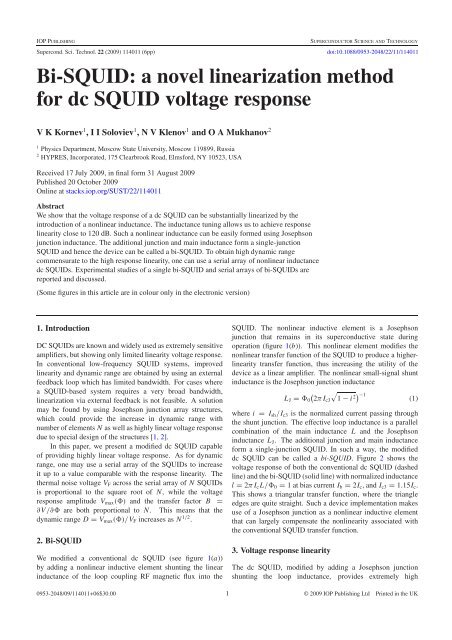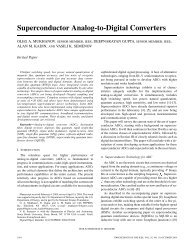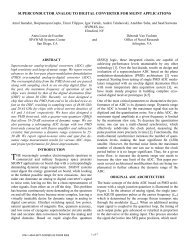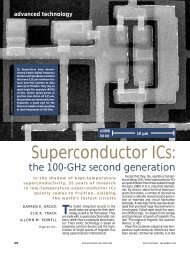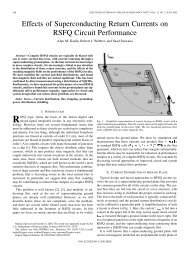Bi-SQUID: a novel linearization method for dc SQUID voltage ...
Bi-SQUID: a novel linearization method for dc SQUID voltage ...
Bi-SQUID: a novel linearization method for dc SQUID voltage ...
You also want an ePaper? Increase the reach of your titles
YUMPU automatically turns print PDFs into web optimized ePapers that Google loves.
Supercond. Sci. Technol. 22 (2009) 114011VKKornevet alFigure 1. <strong>Bi</strong>-<strong>SQUID</strong> (a) and the shunt Josephson junction phaseversus applied magnetic flux (b). Normalized inductance l = 1, biascurrent I b = 2I c , I c3 = 0.85I c .Figure 3. Dependence of the bi-<strong>SQUID</strong> <strong>voltage</strong> response linearity oncritical current of the shunt junction <strong>for</strong> several fixed values ofnormalized loop inductance l at bias current I b = 2I c .Figure 2. Voltage response of conventional <strong>dc</strong> <strong>SQUID</strong> (dashed line)and bi-<strong>SQUID</strong> (solid line) with normalized inductance l = 1atbiascurrent I b = 2I c and I c3 = 1.1I c .linearity with the proper selection of parameters. This issomewhat surprising, since a Josephson junction is a nonlinearinductance. However, the junction nonlinearity is able tocompensate the nonlinearity of the device in order to achievean improved linearity close to 120 dB <strong>for</strong> significant loopinductances (which are necessary to achieve large coupling toexternal signals). One can note that other Josephson nonlinearreactance that functions in a similar way would have a similareffect on reducing the transfer function nonlinearity of morecomplex Josephson systems.The linearity dependence on the shunt junction I c3 oncritical current at different inductances of the bi-<strong>SQUID</strong> loopisshowninfigure3. The linearity is calculated using a singletonesinusoidal flux input (of amplitude A/A max = 0.2, whereA max corresponds to the flux amplitude 0 /4), and measuringthe total harmonic distortion in dB. This result shows thatthe linearity is sharply peaked <strong>for</strong> each value of l, but withdifferent optimized values of I c3 . Very large values of linearityas high as ∼120 dB are achievable. Figure 4 shows how thelinearity parameter varies as a function of the signal amplitude<strong>for</strong> other parameters fixed. The linearity decreases as the signalapproaches the maximum value.A serial array of bi-<strong>SQUID</strong>s can be implemented toincrease the dynamic range up to a value comparable withthe response linearity. Moreover, one can build up a serialSQIF [3, 4] providing a unique <strong>voltage</strong> response with a singletriangular dip at zero applied magnetic flux.Figure 4. Dependence of the response linearity on amplitude ofoutput signal.4. Analytical theoryFigure 5 shows a schematic diagram of a symmetric bi-<strong>SQUID</strong>.In the frame of the RSJ model of an overdamped Josephsonjunction, at I c1 = I c2 = I c one can write the following simpleequations in terms of standard normalized values:i b = i 1 + i 2 , i 1 + i 3 = i 4 , i 2 = i 3 + i 5i 4 = sin ϕ 1 +˙ϕ 1 , i 5 = sin ϕ 2 +˙ϕ 2 ,i 3 = i c3 sin ϕ 3 +˙ϕ 3 ,ϕ 1 + l 2 i 1 = ϕ e + ϕ 2 + l 2 i 2,ϕ 1 + ϕ 3 = ϕ 2 , ˙ϕ 1 +˙ϕ 3 =˙ϕ 2 ,where i c3 = I c3 /I c is the normalized critical current of the thirdjunction, and dots denote time differentiation with normalizedtime τ = ω C t, ω C = 2π 0V C , V c = I c R N —characteristic<strong>voltage</strong>.2
Supercond. Sci. Technol. 22 (2009) 114011VKKornevet alFigure 5. Schematic diagram of a bi-<strong>SQUID</strong>. ‘P’ is an external phasesource ϕ e .The set of equations can be reduced to two equations:2 ˙ϕ 1 −˙ϕ 2 = i b2 + (ϕ e + ϕ 2 − ϕ 1 )+ i c3 sin(ϕ 2 − ϕ 1 ) − sin ϕ 1l(2a)2 ˙ϕ 2 −˙ϕ 1 = i b2 − (ϕ e + ϕ 2 − ϕ 1 )− i c3 sin(ϕ 2 − ϕ 1 ) + sin ϕ 2 .l(2b)It is more convenient to use the sum phase θ = ϕ 2 + ϕ 1 and thedifferential phase ψ = ϕ 2 − ϕ 1 instead of Josephson phases ϕ 1and ϕ 2 . In this case, equations (2a) and(2b) can be rewrittenas follows:˙θ = i b − 2sin θ 2 cos ψ 2 , (3)3 ˙ψ =−2 ϕ e + ψ− 2i c3 sin ψ − 2sin ψ l2 cos θ 2 . (4)In the resistive state, the sum phase θ is the running onewhile the differential phase ψ is a bounded function which maybe represented as a sum of the slow-varying (signal) phase¯ψ depending on applied magnetic flux ϕ e and the oscillatingphase ˜ψ. It is impossible to derive a general analytical solutionof the equation set (3)–(4), but in the case of small parametervalue one can use a <strong>method</strong> of successive approximations <strong>for</strong>solving equations. Such a step-by-step <strong>method</strong> was appliedin [5] to analysis of a <strong>dc</strong> <strong>SQUID</strong> with a small inductiveparameter l ≪ 1.In the case of a bi-<strong>SQUID</strong>, one can consider the oscillatingphase difference ˜ψ as a small term. Due to the shuntjunction, the term ˜ψ remains small at quite practical inductanceparameter l ∼ 1 (this fact is proved by numerical simulations).There<strong>for</strong>e, we may use series distributions <strong>for</strong> θ and ψ asfollows:θ = θ 0 + θ 1 + ..., ψ = ψ 0 + ψ 1 + ....To a first approximation corresponding to θ ≈ θ 0 , ψ ≈ ¯ψ ≈ψ 0 when the small term ˜ψ is neglected, equation (3) convertsto the one <strong>for</strong> a single Josephson junction with critical currentvalue i c = cos(ψ 0 /2) under current biasing i = i b /2:˙θ 02 = i (b2 − cos ψ )0sin θ 02 2 . (5)This equation has the well known analytical solution <strong>for</strong>θ 0 (τ), ˙θ 0 (τ) [6]; in the resistive state, time-averaging of theFigure 6. (a) Voltage dependence v(ψ 0 ) given by equation (6)ati b ≡ I b /I c = 2; (b) phase dependence −ϕ e (ψ 0 ) given by equation (7)at li c3 ≡ 2π LI c3 / 0 = 1.5.oscillating <strong>voltage</strong> v(τ) = 1 ˙θ 2 0 (τ) results in a hyperbolic I –V curve, that in our case can be written as follows:√v = 1 2 〈 i˙θ 2 ( )b0 〉=4 − ψ0cos2 . (6)2Next, we do time-averaging of equation (4) and then come tothe ‘phase’ equationli c3 sin(ψ 0 ) + ψ 0 =−ϕ e , (7)because 〈 ˙ψ〉 =0, and equation (5) determines 〈cos θ 02〉=0. Infact,〈cos θ 02〉= 1 T∫ 2π∫ 2π0cos θ 02dτdθ 0dθ 0= 1 cos θ 0 dθ 0(T 0 2 ib − 2cos ( ψ 0) (2 sinθ0))2(∣ ( )1 ∣∣∣=−T cos(ψ 0 /2) ln ψ0i b − 2cos sin2(θ0)∣ )∣ ∣∣∣ ∣∣∣2π= 0.2The first term in (7) setting a nonlinear relation betweenapplied magnetic flux and differential phase ψ 0 is just the termresponsible <strong>for</strong> <strong>linearization</strong> of the bi-<strong>SQUID</strong> transfer functionv(ϕ e ).The obtained equation set (6)–(7) gives the <strong>voltage</strong>response (transfer function) of the bi-<strong>SQUID</strong> v(ϕ e ) asan implicit function. One can tabulate both functionaldependences v(ψ) and ϕ e (ψ) and then plot the <strong>voltage</strong>response v(ϕ e ). Figure 6 shows both <strong>voltage</strong> dependencev(ψ 0 ) at i b ≡ I b /I c = 2 and phase dependence ϕ e (ψ 0 ) at03
Supercond. Sci. Technol. 22 (2009) 114011VKKornevet alFigure 8. (a) Equivalent circuit of bi-<strong>SQUID</strong> with control stripline<strong>for</strong> magnetic flux application. (b) Equivalent circuit of the bi-<strong>SQUID</strong>cells implemented in a prototype of an active electrically smallantenna.Figure 7. Voltage response v(ϕ e ) given by both <strong>voltage</strong> and phasedependences v(ψ 0 ) and ϕ e (ψ 0 ) at i b ≡ I b /I c = 2<strong>for</strong>li c3 ≡ 2π LI c3 / 0 = 0.58 (a) and 1.5 (b).Figure 9. Microphotograph of serial array of 12 bi-<strong>SQUID</strong>s.li c3 ≡ 2π LI c3 / 0 = 1.5. By varying the parameter li c3 , onecan substantially change the shape of the phase dependence.Figure 7 presents <strong>voltage</strong> response v(ϕ e ) resulting from the<strong>voltage</strong> and phase dependences at different magnitudes ofparameter li c3 . At small magnitudes of this parameter, the<strong>voltage</strong> response shape is close to the dependence v(ψ 0 )shown in figure 6(a). As the parameter li c3 increases, thetransfer function linearity increases and the <strong>voltage</strong> responseapproaches a triangular shape as shown in figure 7(a). Further,at li c3 > 1, the phase dependence ϕ e (ψ 0 ) becomes a multivaluedfunction, and a hysteresis loop appears in the <strong>voltage</strong>response (figure 7(b)).Despite the fact that the developed analytical theory isstrictly valid at strong inequality ˜ψ ≪ π/2 and in the case ofweak inequality equations (6)–(7) should be considered onlyas a first approximation, the obtained theoretical results are ina good agreement with the results of numerical simulations ofthe bi-<strong>SQUID</strong> at inductive parameter l of about 1 and evenat higher values. The numerical simulations were per<strong>for</strong>medusing PSCAN (Personal Superconductor Circuit Analyzer)simulation software [7].5. Experimental studyWe designed, fabricated and tested a single bi-<strong>SQUID</strong>, serialarrays of bi-<strong>SQUID</strong>s and a prototype of an active electricallysmall antenna based on a bi-<strong>SQUID</strong> array. Integrated circuitswere fabricated using a 4.5 kA cm −2 Nb HYPRES process [8].The layout design was done be<strong>for</strong>e the completion ofnumerical simulations aimed at the optimization of circuitparameters, in particular be<strong>for</strong>e obtaining results presentedin figure 3. There<strong>for</strong>e, the critical currents of all Josephsonjunctions in bi-<strong>SQUID</strong>s were chosen to be equal (I c1 = I c2 =I c3 = I c ), while the optimal shunting junction critical currentshould be somewhat less <strong>for</strong> the implemented inductanceparameter l = 1.4.Figure 8(a) shows a schematic diagram of the bi-<strong>SQUID</strong><strong>for</strong> both the fabricated single bi-<strong>SQUID</strong> and the serial arrayof bi-<strong>SQUID</strong>s. To apply magnetic flux, we used a controlstripline coupled magnetically with an additional trans<strong>for</strong>merloop. This loop with high inductance L ex is connected inparallel to inductance L in and there<strong>for</strong>e practically does notchange the interferometer inductance. A microphotographof the fabricated serial array of 12 bi-<strong>SQUID</strong>s is shown infigure 9.Voltage response of bi-<strong>SQUID</strong> measured by automatedsetup OCTOPUX [9] is shown in figure 10. The applied biascurrent was slightly more than the critical current 2I c of the bi-<strong>SQUID</strong>. The shunt junction critical current is not of the optimalvalue at the implemented inductance parameter. As a result, theobserved <strong>voltage</strong> response is not perfectly linear, although itshows a clear triangular shape. The measured transfer functioncoincides closely with the one calculated using the PSCANsimulator. As <strong>for</strong> the small hysteresis at the flux value closeto ± 0 /2, it indicates that the effective inductance parameterof a single-junction <strong>SQUID</strong> l ∗ ≡ li c3 ≡ 2π LI c3 / 0 is4
Supercond. Sci. Technol. 22 (2009) 114011VKKornevet alFigure 10. (a) Voltage response of bi-<strong>SQUID</strong> with equal criticalcurrents of all junctions and inductive parameter l = 1.4. Theresponse was measured by OCTOPUX. The applied bias current wasslightly more than the <strong>SQUID</strong> critical current 2I c .(b) Top part of themeasured <strong>voltage</strong> response and the fit curve (solid line) calculatedusing the PSCAN routine. The fitting parameters are as follows:l = 1.4, l p = 0.3, β c = 0.2, where β c is the McCumber parameter,and l p is the parasitic inductance connected in series with shuntjunction. The instable part of the top loop is shown by dash line.Figure 11. (a) Voltage response of a serial array of 12 bi-<strong>SQUID</strong>swith equal critical currents of all Josephson junctions and inductiveparameter l = 1.4. Hysteresis manifestations on tops of the responseare smoothed due to spread in the array cell parameters and noise.(b) Voltage response of the differential scheme of two serial arrays of12 bi-<strong>SQUID</strong>s frustrated oppositely by nearly half a flux quantum aswell as the source responses of the arrays biased about 10% abovetheir critical current.more than unity and hence the static phase diagram becomeshysteretic. Figure 10(b) shows the top part of the measured<strong>voltage</strong> response and the fit curve (solid line) calculated usingPSCAN. The fitting parameters are as follows: l = 1.4,l p = 0.3, β c = 0.2, where β c is the McCumber parameterand l p is the parasitic inductance connected in series with ashunt junction. The dashed line shows an instable part of thehysteretic loop.The <strong>voltage</strong> response of the array measured by OCTOPUXis presented in figure 11(a). The applied bias currentwas slightly more than the critical current of the array.The hysteresis manifestations on top sections of the <strong>voltage</strong>response are smoothed due to spread in the array cellparameters and noise. The <strong>voltage</strong> response linearity ofboth the bi-<strong>SQUID</strong> and the bi-<strong>SQUID</strong> serial array can beadditionally improved by means of differential connection oftwo identical bi-<strong>SQUID</strong>s or serial arrays oppositely frustrated(figure 12). This improvement results from cancellation ofeven harmonics of the individual responses. Figure 11(b)shows the <strong>voltage</strong> response of the differential scheme of twoserial arrays of 12 bi-<strong>SQUID</strong>s frustrated by nearly half a fluxquantum. The arrays are biased at about 10% above theircritical currents. The increase in the bias current decreasesboth the array response amplitude and the response linearity.Figure 12. The differential connection of bi-<strong>SQUID</strong>s or bi-<strong>SQUID</strong>serial arrays oppositely frustrated can be used <strong>for</strong> additionalimprovement of <strong>voltage</strong> response linearity.Despite this fact, the differential response shows a goodlinearity within a substantially wide range.Figure 13 shows a microphotograph of the fabricatedprototype of an active electrically small antenna based on aserial array of 12 bi-<strong>SQUID</strong>s. Each bi-<strong>SQUID</strong> is equippedwith a large superconducting loop (see the equivalent schemeof such a bi-<strong>SQUID</strong> in figure 8(b)) to sense the magneticcomponent B of an incident electromagnetic wave. To per<strong>for</strong>man initial test of such an antenna, a large-size strip coil wasintegrated on the fabricated chip to excite a low-frequency or<strong>dc</strong> magnetic field. Figure 14 shows the <strong>voltage</strong> response of theantenna prototype with 50 load. The applied bias currentis slightly more than the critical current of the circuit. Theantenna <strong>voltage</strong> response to a spatial magnetic field is just thesame as the one observed <strong>for</strong> array of bi-<strong>SQUID</strong>s with a controlcurrent strip line. This fact confirms the validity of our design.The per<strong>for</strong>mance of such an antenna can be substantiallyincreased by combining with a flux concentrator.5
Supercond. Sci. Technol. 22 (2009) 114011VKKornevet alcan largely compensate the nonlinearity of the conventional<strong>SQUID</strong> transfer function.Theoretically, one can increase the dynamic range byusing a serial array of such <strong>SQUID</strong> elements and determiningthe number of elements by balancing the required signalamplitude with the required amplifier linearity.One should note the peak-like dependence of the linearityparameter on the shunt junction critical current. Thisindicates certain limitations of allowable technological spreadin Josephson junction parameters <strong>for</strong> practical implementationsof a highly linear serial array of bi-<strong>SQUID</strong>s.We designed, fabricated and tested a single bi-<strong>SQUID</strong>,serial arrays of bi-<strong>SQUID</strong>s and a prototype of an activeelectrically small antenna based on a bi-<strong>SQUID</strong> array. Theobtained experimental data are in good correspondence withresults of numerical simulations and can be qualitativelydescribed with the analytical theory developed.AcknowledgmentsFigure 13. Microphotograph of the fabricated prototype of an activeelectrically small antenna based on a serial array of 12 bi-<strong>SQUID</strong>seach equipped with a large superconducting loop to sense themagnetic component B of an incident electromagnetic wave. Alarge-size strip coil is introduced in the chip to excite alow-frequency or <strong>dc</strong> magnetic field.This work was supported in part by the ONR via CRDF grantRUP1-1493-MO-05 and Russian Grants <strong>for</strong> Scientific Schools5408.2008.2 and 133.2008.2.The authors thank Michael Yu Kupriyanov <strong>for</strong> fruitfuldiscussions of the theoretical study presented as well as AlexKirichenko and Henrik Engseth of HYPRES <strong>for</strong> help in layoutdesign verification and testing.ReferencesFigure 14. Voltage response of the antenna prototype with a 50 load. The graph is shown versus the strip coil control current excitinglow-frequency magnetic field.6. ConclusionWe have proposed a so-called bi-<strong>SQUID</strong> in order to achievea highly linear <strong>voltage</strong> response with linearity parameteras high as 120 dB <strong>for</strong> significant loop inductance allowinglarge coupling to external signals. The device exploits aJosephson junction as a nonlinear inductive element, which[1] Kornev V K, Soloviev I I, Klenov N V and Mukhanov O A 2009High linearity SQIF-like Josephson-junction structures IEEETrans. Appl. Supercond. 19 741–4[2] Kornev V K, Soloviev I I, Klenov N V and Mukhanov O A 2009Dynamic range and high linearity issues in multi-elementJosephson structures Int. Supercond. Electronics Conf.(Fukuoka, June) HF-P03 Ext. Abstracts[3] Haeussler Ch, Oppenlaender J and Schopohl N 2001Nonperiodic flux to <strong>voltage</strong> conversion of series arrays of <strong>dc</strong>superconducting quantum interference devices J. Appl. Phys.89 1875[4] Oppenlaender J, Häussler Ch, Traeuble T and Schopohl N 2002Sigmoid like flux to <strong>voltage</strong> transfer function ofsuperconducting quantum interference filter circuits PhysicaC 368 125[5] De Luca R, Fedullo A and Gasanenko G 2007 Pertubationanalysis of the dynamical behavior of two-junctioninterferometers Eur. Phys. J. B 58 461–7[6] Likharev K K 1986 Dynamics of Josephson Junctions andCircuits (New York: Gordon and Breach) p 634[7] Kornev V K and Arzumanov A V 1997 Numerical simulation ofJosephson-junction system dynamics in the presence ofthermal noise Inst. Physics Conf. Ser. No 158 (Bristol:Institute of Physics Publishing) pp 627–30[8] Available online at http://www.hypres.com/[9] Available online at http://gamayun.physics.sunysb.edu/RSFQ/Research/octopus.html6


